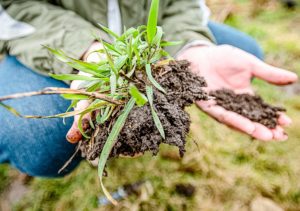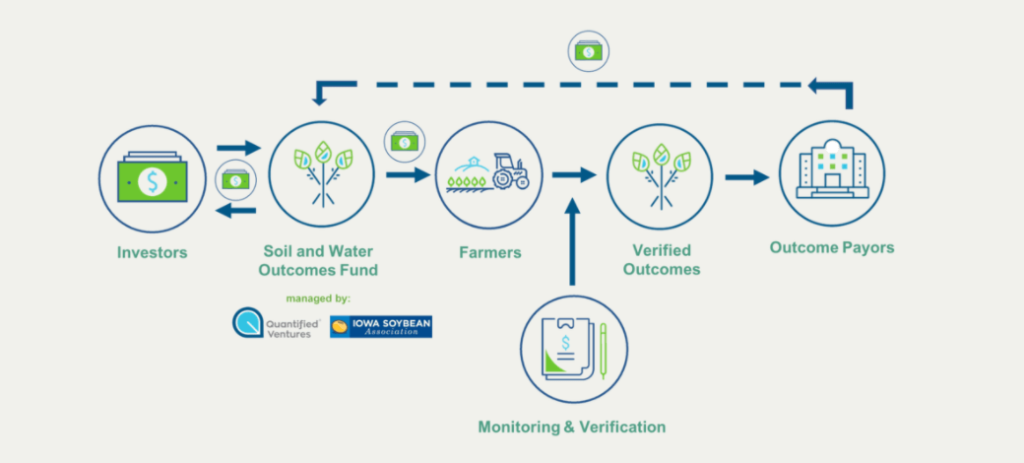| Title | Soil and Water Outcomes Fund |
| Country/Location | USA |
| Size | n/a |
| Revenue Model | Carbon credits, water quality credits |
| Private Investment/Finance Structure | Debt facility, plus some seed capital |
| Public/Philanthropic Investment | Grants from Cargill and Walton Family |
| Env/Social Impact | Improved water quality, carbon sequestration |
Maintaining water quality can be a challenge in agriculture-heavy watersheds and landscapes. Runoff from farm fields often contains sediment and nutrients like phosphorus and nitrate, leading to impairment of source water, increased treatment costs, and economic damages. Increasingly, U.S. municipalities are being forced to upgrade water and wastewater treatment plants to deal with these increased nutrient levels, which can strain municipal budgets and compete with other capital improvement priorities.

Eric Letsinger, founder Quantified Ventures
Traditionally, state governments, the federal government, and philanthropic organizations fund conservation in this area, but that means it is hard to scale. Eric Letsinger, Founder and CEO at Quantified Ventures, says that expecting farmers, which operate on razor-thin margins, to cover some of the up front costs in order to receive public grants, or asking farmers to be fundraisers through philanthropy, is not realistic. “As a result, we don’t have nearly as many of these conservation practices being implemented on farms in the U.S. as everyone would like,” he says.
The Soil and Water Outcomes Fund, launched in 2020 in Iowa, was set up to solve this problem. It is an outcomes-based approach to implementing regenerative agriculture on private lands and is a partnership between Quantified Ventures (through its subsidiary ReHarvest Partners), and the Iowa Soybean Association (through its subsidiary AgOutcomes).
The fund pays farmers up front for the implementation of conservation practices, such as no till and cover crops, which generate positive environmental outcomes. These provide water quality improvements, through the reduction of phosphorus and nitrate, and carbon sequestration.
These outcomes are then independently monitored and quantified by the fund’s partner organization, Sustainable Environmental Consultants, before they are purchased by municipal, government and corporate beneficiaries. Public entities such as municipal water utilities, state departments of agriculture and the federal government that all seek to improve and safeguard water quality buy the water credits, while corporations such as PepsiCo and Nutrien Ag Solutions buy the carbon credits in order to offset the carbon produced in their own supply chains.
Paying for outcomes

The fund uses its own debt facility to pay farmers at the beginning of the growing season to implement conservations practices on their land. Once it has received payments from outcomes buyers, the fund has enough cash to repay its debt, pay interest to The Iowa Finance Authority – which invested $7.5 million of seed capital into the fund – and expand the acreage in the programme. The collateral for the fund’s debt is the multi-year outtake agreements that it has with outcome buyers.
At first, ReHarvest Partners hypothesised that the amount generated by the sale of water credits would cover the cost of paying farmers and leave some margin for reinvestment. “We were wrong about that, so we had to ask ourselves what other outcomes do these conservation practices produce?” says Letsinger. “Many of the farming practices also sequester carbon, so we worked with corporations like Cargill, PepsiCo and McDonalds to see what price they would pay for carbon credits and whether that married with how much it would cost us to produce the carbon outcomes.”
It did, and the stacking of multiple environmental outcomes together within a single transaction enables the Soil and Water Outcomes Fund to pay attractive per-acre payments to participating farmers. It also allows the public and corporate purchasers to pay only for the outcomes they desire, rather than the full cost of program implementation. This is significantly more cost effective than existing “pay for practice” approaches. The fund is also working on adding a third outcome to its program, which is biodiversity.
In its first year of implementation (2020), the Soil and Water Outcomes Fund worked with farmers on 9,500 acres of Iowa cropland. This improved downstream water quality for communities by reducing 172,794 lbs of nitrogen and 11,651 lbs of phosphorus from entering waterways; sequestered 6,407 metric tons of carbon; and paid farmers an average of $37 per acre to implement new conservation practices.
Expansion plans
The fund is now expanding its model to watersheds across the U.S. In 2021, it has enrolled approximately 100,000 acres in the Chesapeake Bay watershed, Illinois, Ohio and Iowa.
In October 2021, the fund announced a new partnership with the Illinois Soybean Association and the U.S. Department of Agriculture’s Natural Resources Conservation Service (USDA-NRCS), to expand its reach to 70,000 acres of farmland in Illinois, Indiana and Missouri in 2022 and another 70,000 acres in 2023. An $8.3 million regional conservation award from USDA-NRCS will pay for the verified water quality outcomes, while contributions from corporate partners Nutrien Ag Solutions and PepsiCo will pay for the verified carbon reductions from enrolled cropland.
Letsinger says the fund’s model is easily scalable and that the plan is to enroll 10 times as many acres across the country every year for the next four years. “That feels very doable, mostly because we’ve already done all the ground work in Iowa and we have off take agreements in place,” says Letsinger. “There are 23 million possible acres we could enrol in Iowa alone.”
Now that the fund has expanded to North Carolina, Ohio, Maryland and Illinois, Letsinger says it is three-quarters of the way done through building the initial infrastructure and getting to an initial 25,000 acres in each of those states. “Once you’ve reached that point and have all the parties in place, setting the goal for 250,000 for the next year is doable,” he says.
Sources:
https://www.theoutcomesfund.com/
https://www.quantifiedventures.com/
https://www.ilsoy.org/press-release/soil-and-water-outcomes-fund-project-plans-scale-illinois-indiana-and-missouri
https://www.edf.org/sites/default/files/documents/Evaluating%20Best%20Practices%20from%20State%20Revolving%20Funds%20vF.pdf
Interview with Eric Letsinger, founder and CEO at Quantified Ventures
